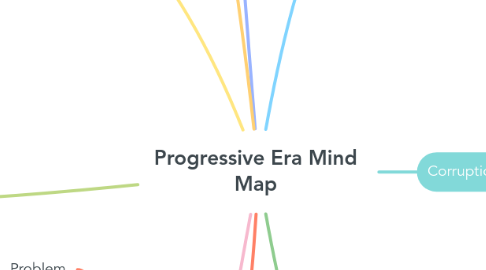
1. Racism
1.1. Problem
1.1.1. Restricting rights of African Americans.
1.2. Reformers
1.2.1. W.E.B. Dubois
1.2.1.1. Booker T. Washington
1.2.1.1.1. Ida B Wells
1.3. Solutions
1.3.1. Started an organization called N.A.A.C.P. They worked hard to end discrimination against African Americans in the US.
1.3.1.1. Leader to achieve equality. Founded the Tuskegee Institute in Alabama. Helped African Americans learn trades and gain economic strength.
1.3.1.1.1. She worked to fight against black lynchings in the South.
2. Conservation
2.1. Problem
2.1.1. There was a loss of natural resources.
2.2. Reformers
2.2.1. Teddy Roosevelt
2.3. Solutions
2.3.1. When congress refused to establish more parks, Teddy used the antiquities act to create national monument instead. He pushed for federal laws that would make business and companies obey laws regarding the use of natural resources.
3. Prohibition
3.1. Problem
3.1.1. Alcohol was leading to insanity and violence and that led to poverty.
3.2. Reformers
3.2.1. Mary Hunt
3.2.1.1. Carrie Nation
3.2.1.1.1. 18 amendment
3.3. Solution
3.3.1. Banned the manufacture and sale of alcohol in the United States. Saloons were forces to close.
3.4. Unintended Consequences
3.4.1. Speakeasies
3.4.1.1. Bootleggers
3.4.1.1.1. Organized Crime
3.5. Solution
3.5.1. As the 18th amendment was being passed, people got upset. Speakeasies began which were illegal nightclubs. Organized Crime rates going up show that this ban wasn't the best thing afterall, and appealed the decision by the 21st amendment. Bootleggers made money by illegally transporting alcohol and selling it to people.
4. Suffrage
4.1. Problem
4.1.1. Women fought longer for the right to vote than they did for any other reform.
4.2. Reformers
4.2.1. Elizabeth Cady Stanton
4.2.1.1. The 19th Amendment
4.2.1.1.1. Susan B. Anthony
4.3. Solutions
4.3.1. Focused on getting each state to allow its women to vote.
4.3.1.1. Gave women full voting rights.
4.3.1.1.1. Became the National American Women Suffrage Association (NAWSA) President. Worked with Elizabeth Cady Stanton
5. Worker's Rights
5.1. Problem
5.1.1. A lot of Americans became factory workers, but they got payed very little and they had long work days in unsafe and unsanitary conditions.
5.1.1.1. Most factory workers couldn't make enough money to support their family so their children had to work in factories and
5.2. Reformers
5.2.1. Samuel Gompers
5.2.1.1. American Federation of Labor (AFL)
5.3. Solutions
5.3.1. Fought for laws that would limit the work to 8 hours so they had shorter work days.
5.3.1.1. Worked hard to make changes in workplaces. This limited work hours and increased wages.
6. Health and Safety
6.1. Problem
6.1.1. People were eating contaminated food. These people would get very weak, some even died because of lead poisoning.
6.2. Reformers
6.2.1. Upton Sinclair
6.2.1.1. Alice Hamilton
6.2.1.1.1. Lillian Wald
6.3. Solutions
6.3.1. Wrote a novel called "The Jungle" to expose the lack of safety and sanitation for workers in the meat packing industry.
6.3.1.1. She taught factory workers how to make their factories safer and keep the air clean for their workers.
6.3.1.1.1. She was a nurse who thought of the idea to send nurses to people who were too sick or poor to go to hospitals. Started a visiting nurse program so nurses could help sick people at home.
7. Poverty
7.1. Problem
7.1.1. Cities were overcrowded and family could not afford to buy homes.
7.2. Reformers
7.2.1. Jacob A Riis
7.2.1.1. Jane Adams
7.3. Solutions
7.3.1. Jacob inspired people to join in efforts to reform laws and improve living in the slums.
7.3.1.1. Jane Adams bought a house and turned it into a settlement house to provide services for poor people in the community.
8. Corruption
8.1. Problem
8.1.1. Governments became increasingly corrupt.
8.2. Reformers
8.3. Solutions
8.3.1. Promoted three government reforms.1- Initiatives allowed voters to propose laws. 2- Referendums allowed citizens to vote on proposed laws. 3- Recalls allowed people to vote a government official out of office.
8.3.1.1. Wisconsin became the first state to establish a direct primary where voters choose candidates for the parties to run in elections under Progressive Governor, Robert Follette.
8.3.1.2. William S. U'Ren
8.3.1.2.1. Robert M. LA Follette
9. Child Labor
9.1. Problem
9.1.1. Children had to work with dangerous machines. Families were poor, paid very little money.
9.2. Reformers
9.2.1. Lewis Hine
9.3. Solutions
9.3.1. Helped to inspire support for child labor laws and compulsory education.
